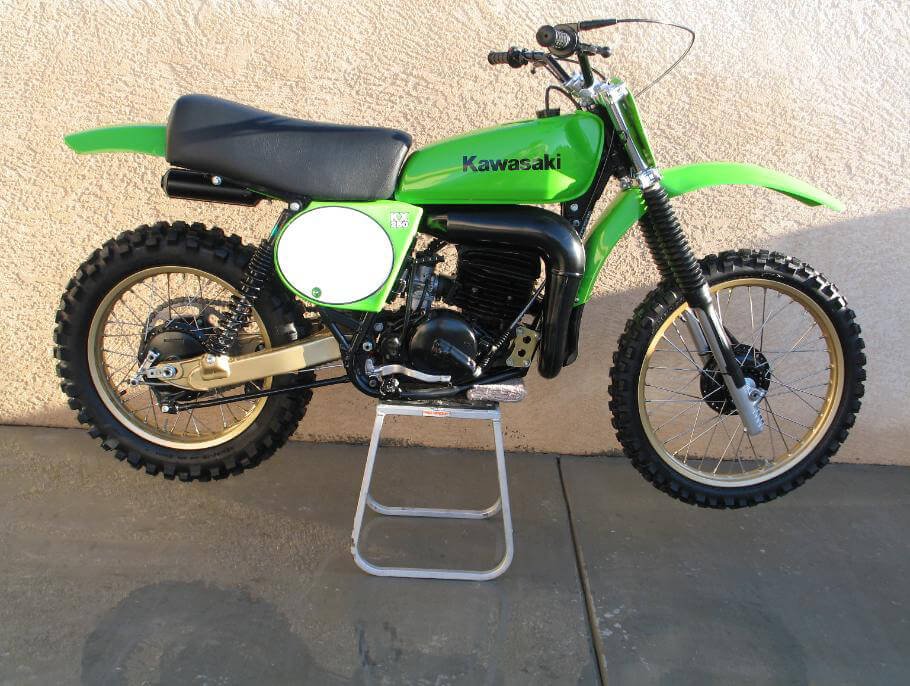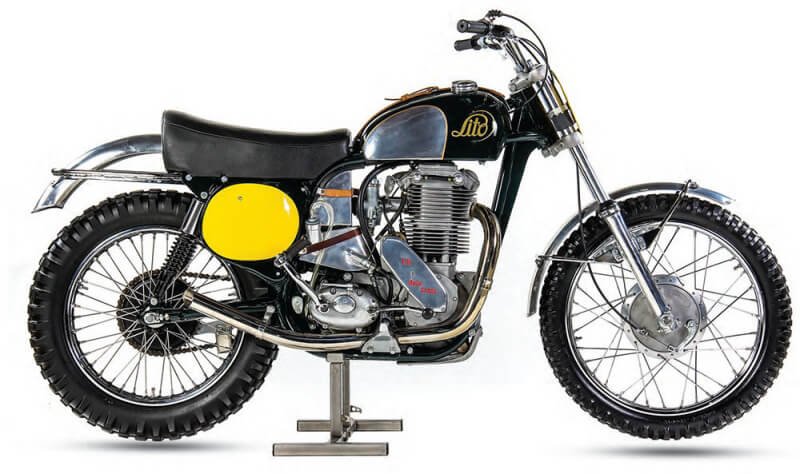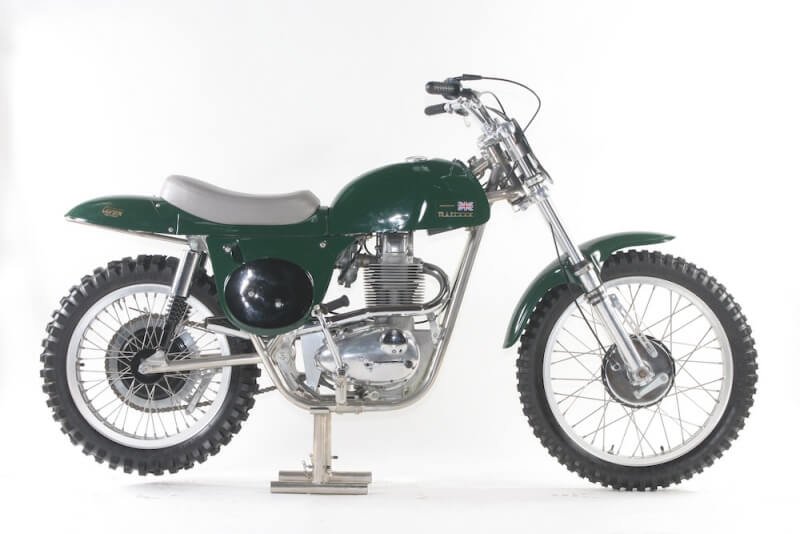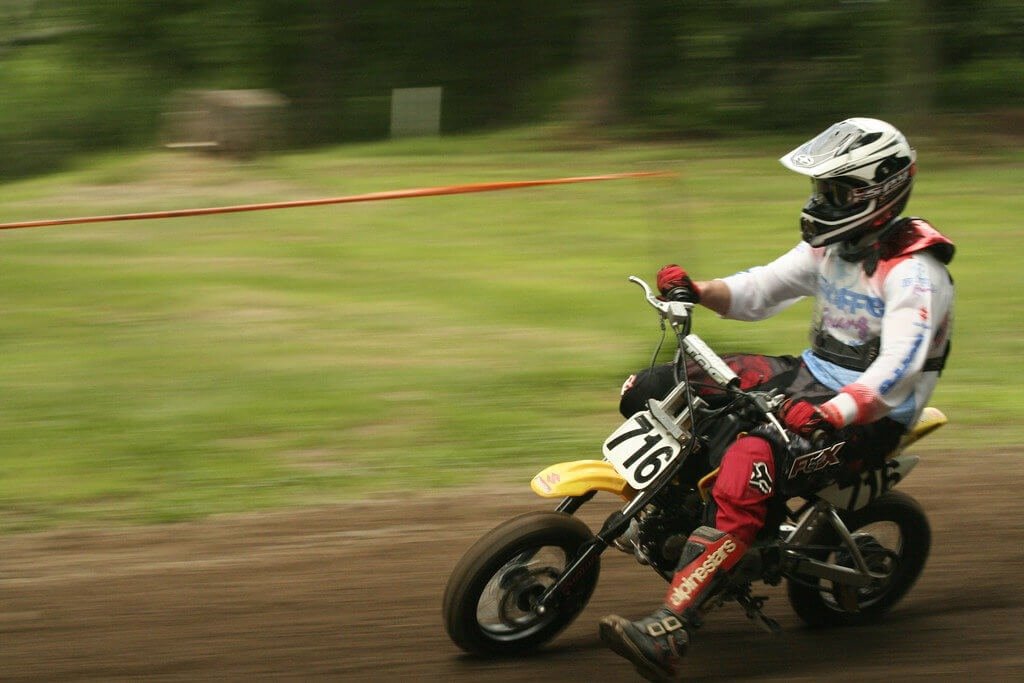These are 12 of the Rarest Dirt Bikes Ever Made
While there are plenty of amazing modern dirt bikes, there’s something about getting on the back of something rare and old that makes everything even more exhilarating.
Maybe it’s the thrill of knowing that everything underneath you is governed not by computers, but by good ol’ fashioned mechanical engineering. Or maybe it’s the idea that the bike could break down at any moment.
But hey, you could fix it with a set of hand tools instead of needing to pay a shop for electronic diagnostics.
Finding any of these bikes today is nigh-on impossible. After all, these were dirt bikes from day one. They were made to be ridden hard and put up broken, and all but a handful of each of these bikes likely rusted away a long time ago.
In the vintage bike community rarer is always better, but you’re about to see that cost doesn’t always equal desirability.
We found 12 of the rarest dirt bikes that we would love to hop on. So in no particular order, these are our top picks along with some of The Best Vintage Dirt Bike Brands to Look For and 7 Tips for Buying Rare Vintage Dirt Bikes.
12 of the Rarest Dirt Bikes We Want to Ride
1. 1961 Lito 500 Motocross (Est. Value $55,000)
This Lito was a major player in the earliest years of motocross.
Not only was it known for having groundbreaking construction but many talented riders used it. You might even remember seeing Sten Lundin ride the Albin-powered Lito to win the 1961 FIM 500cc World Motocross Championship.
For those of us that weren’t alive during that time, it’s important to note that this bike came from a rivalry between Great Britain and Sweden. They were racing to build the best four-stroke bike possible during the 1950s and 1960s. That’s where Nils Hedlund, a Swedish builder, comes into the picture. He paired some of the best British construction with an upgraded chassis and engine.
Hedlund effectively gave the Swedes an advantage with this build. While several replicas have been constructed of the Lito 500 Motocross, it’s estimated that there are only 35 originals. That’s why it’s super rare and quite pricey as well.
2. 1968 Suzuki TM250 (Est. Value $40,000)
You might know that the TM250 is the first motocross bike from Japan.
Back in 1966, Suzuki had two engineers work with a road racer to develop a motocross bike in Europe. They tested out both twin engines and single-cylinder models, but finally settled with a single-cylinder. It was influenced by the 1965 CZ Twin-Port 250 bike.
At first, the Grand Prix results weren’t that fabulous. Then, Suzuki put their efforts back into it and improved the machine. The 1967 version was called the RH67. Unfortunately, the subpar handling and peaky power didn’t hold up against European bikes from CZ and Husqvarna. Even still, Suzuki built more than 100 of them and sent 65 of them to the States. That’s where the Suzuki TM250 came from.
Several racers rode it including Gary Conrad, Walt Axthelm and Preston Petty. That’s what helped it to become one of the top collector motocross bikes in the United States. When it was sold, it came complete with a parts kit that contained replacement clutch parts, carburetor jetting, gearing plus pistons and rings. You know, because those things tend to go bad all the time, right?
If you can get your hands on one of these today for $40k, you should scoop it up. Projections state that this bike could be worth more than $100k in the next ten years.
3. 1975 Puch MC250 Twin Carb (Est. Value $30,000)
Puch is an Austrian company that employed Harry Everts, the Belgian motocross rider in 1974 to race during the FIM 250cc World Motocross Championships. It took a year before he found the sweet spot. That’s when he dominated the Suzukis and ended up taking four championships in a row.
The 1975 Puch MC250 featured a Marzocchi suspension, magnesium cases, a clean frame design, magnesium hubs and forks plus a twin carb setup. It came with a Bing carburetor that had the traditional piston port setup plus a second carb that fed the rotary valve located on the engine’s right side.
In total, there were only 90 of these machines produced in 1975, but they weren’t sold until 1976. If you can find one, you have yourself an extremely rare dirt bike indeed.
4. 1968 Bultaco 360 El Bandido (Est. Value $15,000)
The Spanish Bultaco El Bandido arrived on the scene in 1967. At the time it was only a 350cc model, but the company later increased the bore size to 85mm from 83mm. This gave it 362cc plus 43.5 horsepower. You could find both a scrambler and motocross model of this exquisite machine.
The American model featured a longer wheelbase of 55.9 inches. It also came with a 31-degree head angle that made it perform better on a scrambler track. While it might not be worth the same amount as our top three rarest dirt bikes, it sure would be a lot of fun to ride.
5. 1965 CZ250 Twin Port (Est. Value $14,000)
This CZ250 twin-port bike is actually a replica of the company’s GP bike of the day. What a time, right?
Joel Robert, a Belgian rider, won the 1964 250cc World Championship while riding the production model 250 twin-port. The very next year, Viktor Arbekov, a Russian rider, took the 1965 title which further elevated the bike’s popularity.
If you plan to purchase one of these, buyer beware. There have been many reports of sketchy history with these bikes and it’s easy to get ripped off by a well-prepared fake. Make sure you check the condition and history well and know exactly what you are getting into.
6. 1968 BSA B44 Metisse 500 (Est. Value $14,000)
In the 1960s, the Metisse was highly coveted for one defining feature: its groundbreaking frame.
Rickman Metisse designed a state of the art chassis. Both him and his brother were GP riders which helped when it came time to engineer the BSA BB4 Metisse 500. This chassis paired perfectly with the lightweight Westlake top end and BSA B44 engine, creating quite a dominant powerhouse.
You will still find these in AHRMA events even today.
Many riders continue to prefer this bike because it features tractable power, precise handling and light weight considering it is a four-stroke.
7. 1966 Husqvarna 250 Cross (Est. Value $14,000)
Edison Dye is known as the man that helped spread motocross as a popular event in America. He saw the popularity in Europe and knew it would be a success here as well. To do this, he had to import bikes and GP riders in order to run the first races of the series.
At the time the Husqvarna 250 Cross was the best machine to pick from. Once Torsten Hallman won the World Championship plus the Inter-Am astride a 250 Cross, Americans wanted them even more. To further fuel the desire, about a hundred of these bikes were imported to the States for private sale.
While there are several models available, you’ll notice some small differences between them. The 1966 model features a 19-inch front wheel, a frame that’s bolted together and smaller crankcases. In addition, both the ‘66 and ‘67 models had a burgundy color.
We truly believe that all collectors should strive to own one of these Husqvarnas as a centerpiece of their collection, but only the lucky few will succeed.
8. 1974 Yamaha YZ250A (Est. Value $14,000)
The Yamaha DT1 first hit the scene in 1968. That’s also when Don Jones began a new development program for his two sons, DeWayne and Gary. Yamaha worked closely with the Jones team and helped Gary to win both the 1971 and 1972 250 National Championships.
The 1974 Yamaha YZ250A is the Jones modified version that hit production during 1974. It featured whittled-down forks, a low-slung engine, a gas tank with loop-ring straps and the finest modern engineering throughout.
9. 1973 Honda CR250M Elsinore (Est. Value $12,000)
The first Honda CR250 Elsinore was produced at the end of 1972. It didn’t go on sale until the Spring of 1973. Of course, there was a lot of excitement surrounding this model because of a campaign featuring the legend himself, Steve McQueen.
When compared to the European bikes, this Elsinore had updated ergonomics, electrics, durability, carburetion and overall user-friendliness. It also came with some conservative styling, magnesium engine cases and an aluminum gas tank that had a satin finish.
Gary Jones raced an Elsinore during the AMA Nationals in 1973. This was Honda’s first 250cc National Championship win. They couldn’t have been happier with the results, and today’s auctioneers and classic bike collectors couldn’t be happier either.
10. 1967 Greeves 250 Challenger (Est. Value $10,000)
At first, Bert Greeves didn’t even want to become a motorcycle manufacturer. He was doing well with his business of building carriages used by invalids. But by the early 1960s, Greeves bikes had become one of the most sought-after off-road two-stroke dirt bikes around.
The 1967 Greeves 250 Challenger came along at the height of his popularity but was also the last primary bike for the brand. Once motocross hit America, exotic CZs and lighter Huskies became the bikes everyone wanted. Still, riders such as Gary Bailey, Bryan Wade and Dave Bickers all gave the Greeves a go.
The majority of these bikes came to the United States through Nick Nicholson, a Greeves distributor. You can still buy parts for them today which make them a great bike to not only collect and work on, but actually ride as well.
The aluminum I-beam frame combined with the wild Earles front suspension makes the Greeves one of the most visually stunning motorbikes of all time. Prices are always reasonable despite the vintage appeal.
11. 1978 Kawasaki KX250A4 (Est. Value $10,000)
At first glance, you might think this is just another Kawasaki, but there’s a real story behind this bike.
In fact, only 1500 of them were made worldwide and just 600 saw the shores of America. As such, it’s nearly impossible to find parts for them or to find these bikes in running condition.
From 1973 through 1976, Kawasaki was getting their ass beat by Ossa, Penton, Suzuki and Yamaha on the MX circuit. To focus on R&D, they decided to shut down the production of the KX line in 1977. What they came up with next was the 1978 Kawasaki KX250A4.
It weighs only 210 pounds, pumps out 40 horsepower and features a chromalloy frame, gold wheels, aluminum gas tank, gold motor mounts and a gold swing arm. It even comes with air charged front shocks and KYB oil charged rear shocks.
Just take a look at that monster 18-inch wheel in the rear with the 21-inch front wheel to boot, a crazy feat for the time which would help set the tone for dirt bikes of the modern age.
12. 2009 ATK Intimidator 700 cc 2 stroke (Est. Value $10,000)
We’ve finally reached the modern age, an age of high horsepower and insane torque.
If a modern classic dirt bike is what you want, then this 2009 ATK Intimidator is right for you. Sure, it’s not vintage like all the other options on our list, but despite being modern it’s one of the rarest dirt bikes ever made.
That’s mainly because most people can’t handle the power this beast puts out.
Even if you opted for the smaller model that featured just a 620 engine, you were still looking at one of the fastest dirt bikes in the history of the world. With the 700 you received a mighty 685cc two-stroke that pumped out 78 horsepower and boasted a top speed in excess of 110 mph.
It also weighed just 238 pounds dry. That’s about the same weight as a Honda Grom!
This is one modern classic which will only get better with time.
The Best Vintage Dirt Bike Brands to Look For
If you aren’t in the market for the rarest dirt bike in the world but you still want to ride a vintage steed, there’s a lot of ways to cure your desires.
You need to know that there are quality vintage bikes and poorly constructed ones, just like they are new. You have to understand what you are looking for in order to get the best deal.
Before purchasing, you should always consider how easy it will be to find parts, what the reliability is and does it retain its resale value in case you want to get rid of it later.
Here are some bike brands that are real winners if you want a vintage dirt bike.
Bultaco
The Pursangs were supremely reliable and offered fast speeds. Not only that, but a rebuilt model can come across very classy when done right. You might also consider the 1968 Bandito. This insane rocket ship demands respect on and off the trail.
No-go: Stay far from the Astros. The lifespan of a 1971 to 1973 model was more like a mayfly than a bull.
CZ
Look for one of the earlier twin-pipe models, even if it’s not in perfect condition. These continue to rise in value and are a great investment. Other options include 1970 or 1971 250, 360 and 400 models.
No-go: What you don’t want is a 1973 or 1974 250 Enduro. It featured a lot of previous year’s parts and the bike itself was incredibly slow. You also want to avoid the 125 racer. It weighs more than the 400, horsepower is non-existent and the suspension was stubby at best.
Greeves
You will have trouble finding parts for any Greeves bike. Still, the story behind the brand and the resale value of most models makes them appealing and they are quite unique. We would pick the late 1960s or early 1970s 250s and 360s. You might also consider the 1972 or 1973 380 QUB.
Hodaka
Look for a 1972 to 1973 Super Rat or Combat Wombat. Parts are easy to get your hands on and both of these bikes have plenty of personality.
Honda
If you can get your hands on an old XR-75, then you would be riding one of the best pit bikes ever. Look for a 1973 125 or 250 Elsinore for a vintage racer. Just make sure it’s clean and cared for.
No-go: The worst four-stroke ever to exist must be the 1973 XL175. The XL350 wasn’t much better.
Husqvarna
Late 1960s models until 1971 are all good. Heck, this is one of the most recognizable names in the history of motorsports. You’re hard-pressed to find one nobody wants.
No-go: Stay away from a 1972 or 1973 because they weighed 25 more pounds and weren’t reliable. If you prefer a 1974, that works too, but avoid a 450 Desert Master.
Kawasaki
In the late 1960s, Kawasaki produced a 100cc racer which put out 18.5 horsepower: the Centurion is a quality bike that puts many others to shame. You could also look for the 238cc rotary-valved racer from the 1970s that offered plenty of lower-end torque and massive horsepower.
No-go: You will probably want to avoid the 1972 Bighorn. Anything that earned the nickname Pighorn isn’t worth your time. Also, stay far from the 1974 MXers.
MAICO
Any square-barrel model will work from 1970 to 1972. 1973 and 1974 Radial 250s and 400s are always winners.
No-go: Avoid the 450cc because they didn’t offer any faster speeds and faced trouble with the clutches. Another one you don’t want to buy is the six-speed 125cc Maico. It was troublesome to service and you’ll have issues with the gearbox.
Montesa
No-go: You might want to skip over this brand completely. While the Cappra might be doable, the rest of the lineup isn’t worth its weight.
Ossa
Look for an early 1970s Stiletto. It featured a 250cc engine, superior reliability and plenty of power. This Spanish company also released a 1974 Phantom which is valuable. It weighs 197 pounds and offers lots of performance. And as far as obscure brands go, this one is pretty out there.
Penton
KTM and Penton worked together to create many bikes. One of the best is the 250 plus the Mint 400. You can still win a race with these and there are plenty of parts available.
Suzuki
Ah, the big gun has arrived. The 1973 or 1974 TM-250 Challenger is our top Suzuki pick, mainly because it’s light and small. While it does have its share of handling quirks, you’ll get reliability and speed.
No-go: You are going to find an abundance of cheap 1970s TM400 Cyclone bikes, but don’t get caught up in the hype. They feature virtually no horsepower and aren’t good for anything. You heard it here first.
Triumph
If you’ve never ridden a Triumph, you are missing out on life. One of the best dirt bikes ever made is the Rickman Triumph and you should scoop it up if you find one in good condition.
Yamaha
If you want a vintage trail bike, you could pick any DT-1. The earlier MXers from 1969 through 1971 weren’t superior handlers, but they were fast. There is also a bunch of mods you can do to make them run better. Finally, an early YZ would also make an excellent bike plus the horsepower competes with many modern dirt bikes.
No-go: The worst bike ever produced from Yamaha is the SC500 Scrambler. The four-speed transmission often seized and the steering shook like a Mexican jumping bean. You should also avoid the RT-MX because the handling isn’t much better even there.
7 Tips for Buying Rare Vintage Dirt Bikes
When you start your hunt for vintage racers and rare dirt bikes, you might be tempted to purchase more than one. Go for it! After all, you only live once. On top of that, if you can find a few of the same model, you save yourself time looking for parts. Which you inevitably will.
Here are a few other pointers you might find valuable.
Tip #1: Restored or unrestored?
You have two options with your purchase. You can spend more for an already restored racer or purchase a junker that needs work. If you choose the latter option, make sure you negotiate that price way down.
Tip #2: Check the condition
These bikes have often sat for a very long time. Make sure you look at the areas that see chronic wear. For example, if you plan to buy a vintage CZ, watch the swingarm. If it wasn’t serviced, it often froze and was ruined. It does you no good to get a bargain on a 1971 Maico 400 when it has a blown clutch and bad drive.
Check anything that’s supposed to move, look inside the gas tank for rust, and if possible peek inside the engine with a boroscope. Above all else, make sure the engine is free unless you’re okay with unwrapping a mystery.
Tip #3: Buy lots of parts
When you decide on the bike you want, stock up on parts. You’ll want to keep an inventory of other pistons, rings and critical parts. Make sure you carry spares for some expendable items like spark plugs, filters, lines, and hoses along with the tools to make a fix on the side of the road.
That would have been a good idea even when these were new, let alone decades later.
Tip #4: Invest in a manual
It always pays to have the corresponding shop manual close at hand. This will offer you all the sizes and part numbers of every component you might need.
Tip #5: Start working with fiberglass
Knowing how to ‘glass enables you to fix fender and body damage on these vintage dirt bikes. Once you have the metric measurement sizes, you should be able to perfectly duplicate whatever you need after you learn the necessary skills to do so.
Tip #6: Look for interchangeable parts
What many people don’t realize is that many parts of old dirt bikes are interchangeable.
For example, many Euro bikes feature interchangeable bearings, rings and pistons. You’ll also find that Maico and Husky clutch plates are nearly identical. If you have a Suzuki, Kawasaki or Yamaha, you might even see that they use a lot of the same internal components.
These vintage dirt bike shared more parts than you might think, so do your homework to avoid paying more just because something has a certain brand name on it.
Tip #7: Ride your bike often
Once you restore your vintage dirt bike, don’t forget to enjoy it. It makes absolutely no sense to build it and then stick it under a sheet. Not to mention, that’s when all the problems really start creeping in.
What a waste!
Bring the past alive and share your dirt bike with the world. Who knows, you might inspire others to become interested in vintage dirt bikes simply from seeing yours. You could change the world.
What vintage dirt bike do you love?
Do you have a collection of the rarest dirt bikes known to man? Did we miss your favorite one? We would love to hear about it.
Leave us a comment and let us know if we missed anything you think should have made the list.



































Dirt biking remains a vibrant and evolving culture as we head into 2025. Gas-powered bikes continue to see steady, incremental improvements, while electric dirt bikes are rapidly advancing with lighter components, longer battery life, and impressive torque. Legislative efforts like House Resolution 906 aim to empower riders with the right to repair their own vehicles, fostering independence within the community. Despite restrictive state regulations, dirt biking culture thrives, with growing sales and creative solutions like Montana LLC registration ensuring riders can hit the trails legally. The future of dirt biking is a blend of tradition, innovation, and resilience.